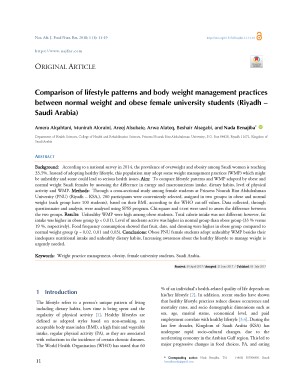Comparison of lifestyle patterns and body weight management practices between normal weight and obese female university students (Riyadh – Saudi Arabia)
Abstract
Background: According to a national survey in 2014, the prevalence of overweight and obesity among Saudi women is reaching 33.5%. Instead of adopting healthy lifestyle, this population may adopt some weight management practices (WMP) which might be unhealthy and some could lead to serious health issues. Aaim: To compare lifestyle patterns and WMP adopted by obese and normal weight Saudi females by assessing the difference in energy and macronutrients intake, dietary habits, level of physical activity and WMP. Methods: Through a cross-sectional study among female students at Princess Nourah Bint Abdulrahman University (PNU) (Riyadh – KSA.), 200 participants were conveniently selected, assigned in two groups in obese and normal weight (each group have 100 students) based on their BMI according to the WHO cut-off values. Data collected through questionnaire and analysis was performed using SPSS program, Chi-square and t-test were used to assess the difference between the two groups. Results: Unhealthy WMP were high among obese students. Total calorie intake was not different; however, fat intake was higher in obese group (p<0.01). Level of moderate active was higher in normal group than obese group (33% versus 19%, respectively). Food frequency consumption showed that fruit, date and dressing were higher in obese group compared to normal weight group (p-value = 0.02, 0.01 and 0.03). Conclusions: Obese PNU female students adopt unhealthy WMP besides their inadequate nutritional intake and unhealthy dietary habits. Increasing awareness about the healthy lifestyle to manage weight is urgently needed.
Full text article
Authors
Copyright (c) 2017 Authors

This work is licensed under a Creative Commons Attribution 4.0 International License.
-
Attribution — You must give appropriate credit, provide a link to the license, and indicate if changes were made. You may do so in any reasonable manner, but not in any way that suggests the licensor endorses you or your use.
-
No additional restrictions — You may not apply legal terms or technological measures that legally restrict others from doing anything the license permits.





